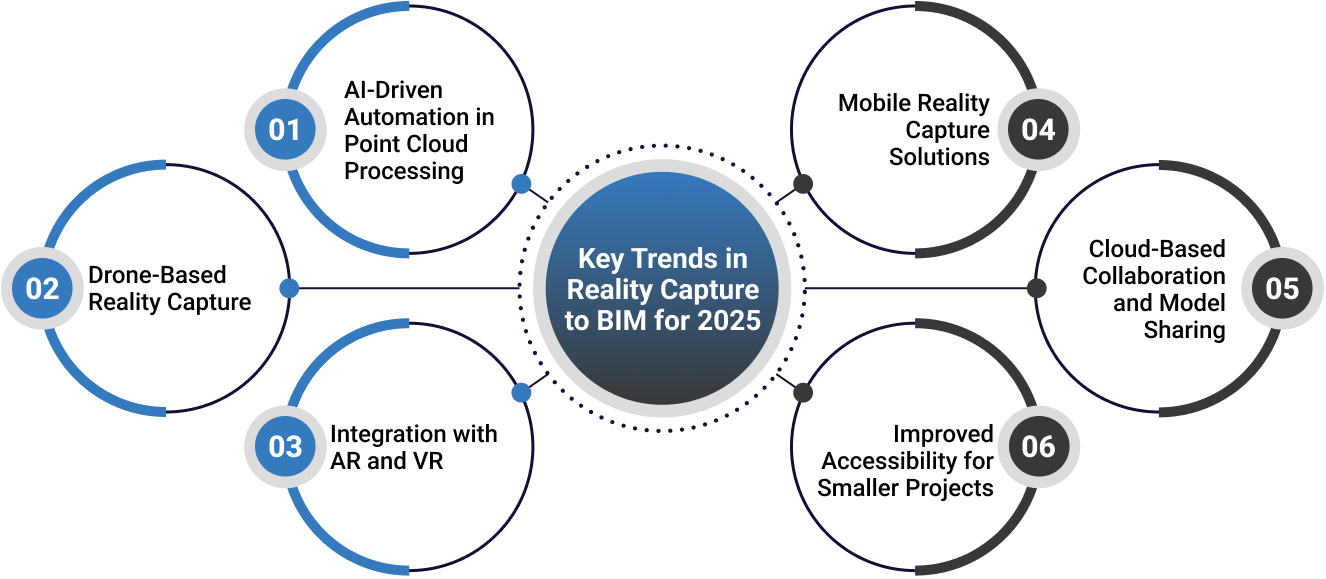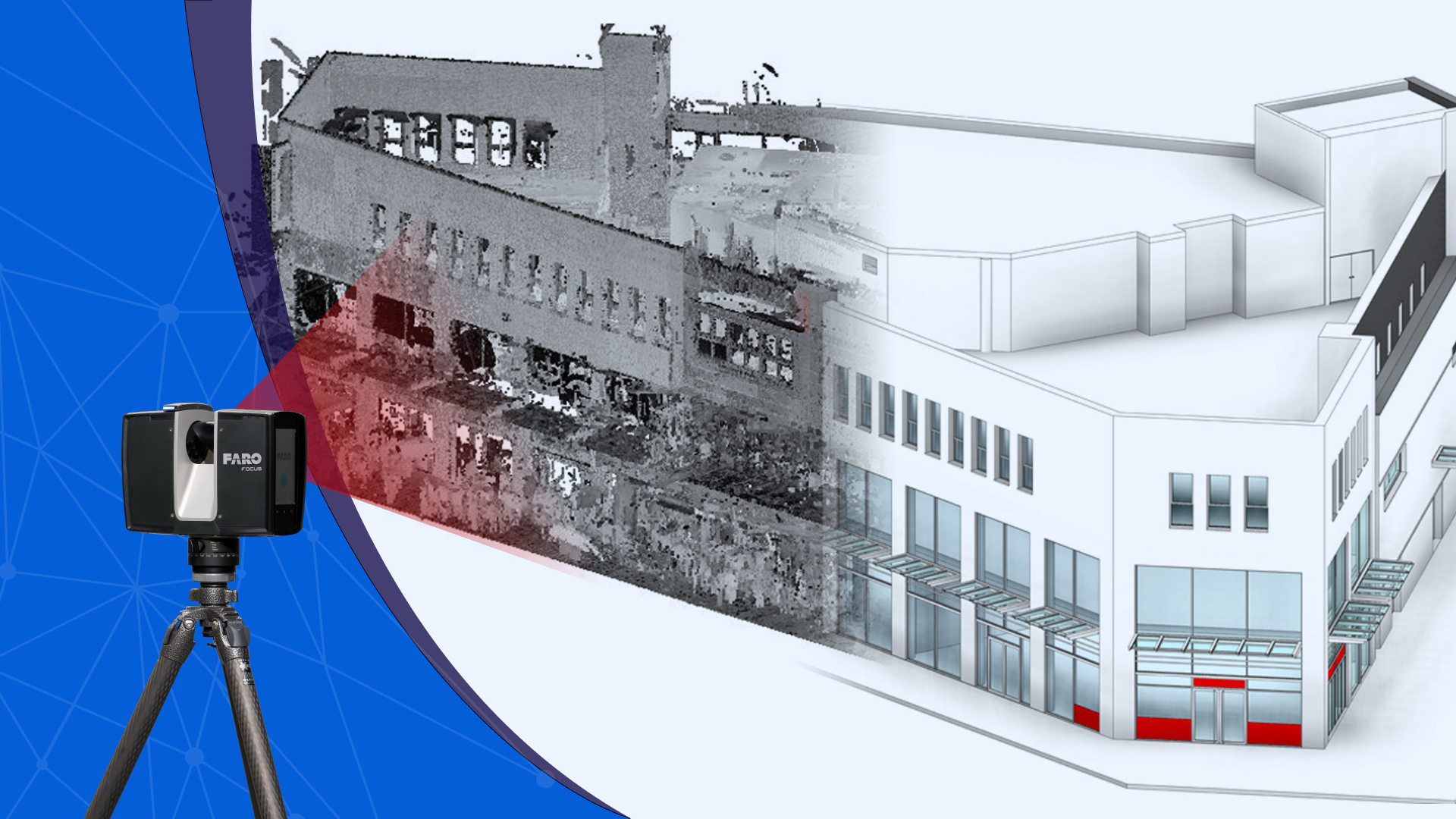As we move into 2025, the evolution of Reality Capture to BIM service is transforming how we design, construct, and manage buildings. Reality capture technology, which includes laser scanning, photogrammetry, and drone imagery, allows for highly accurate and detailed 3D models of physical spaces. When combined with BIM, these models serve as the foundation for intelligent, data-rich building management systems. This blog explores the latest trends, technological advances, and predictions for Reality Capture to BIM in 2025, illustrating why these services are essential for the modern construction industry.
Reality Capture to BIM involves capturing a structure’s physical characteristics and converting them into a 3D digital model that reflects its actual state. This process is highly accurate and uses point clouds generated from laser scans or photogrammetry to create an as-built model in BIM software. These models can be used for design, construction, renovation, and facility management, offering an invaluable tool for professionals across the architecture, engineering, and construction (AEC) sectors.
Why is Reality Capture to BIM Essential for 2025?
In 2025, the Reality Capture to BIM services will be crucial for enhancing project efficiency, reducing errors, and supporting sustainable practices. With Reality Capture to BIM, AEC professionals can:
- Increase Project Accuracy: Capture precise as-built conditions, reducing costly rework caused by differences.
- Enhance Decision-Making: Provide detailed insights that allow for data-driven decisions across the project lifecycle.
- Support Sustainability Goals: Enable retrofitting projects aimed at improving energy efficiency by accurately assessing existing building conditions.
- Simplify Communication: Reality Capture to BIM models foster collaboration across multidisciplinary teams, ensuring a single source of truth.
Key Trends in Reality Capture to BIM for 2025

As Reality Capture to BIM technology evolves, several trends are shaping its future:
AI-Driven Automation in Point Cloud Processing
AI and machine learning are playing a transformative role in Reality Capture to BIM services by automating the point cloud processing and modeling stages. Advanced algorithms can now identify structural components, recognize objects, and create 3D models from point clouds much faster than traditional methods. In 2025, expect more AI-powered software that can significantly reduce manual intervention in point cloud conversion.
Drone-Based Reality Capture
Drones have revolutionized how we capture building exteriors, especially for large or complex structures that are challenging to scan manually. Drones equipped with photogrammetry or LiDAR sensors are increasingly used in Reality Capture to BIM services. This trend will continue to rise in 2025, providing faster and more flexible data collection, particularly for high-rise buildings, industrial plants, and remote sites.
Integration with AR and VR
AR and VR technologies are enhancing Reality Capture to BIM workflows by allowing professionals to visualize 3D models in a more immersive way. In 2025, AR and VR integrations will enable project stakeholders to view, interact with, and modify models directly from the field. This real-time interaction improves decision-making and helps identify potential design issues early in the process.
Mobile Reality Capture Solutions
Mobile scanning devices are gaining popularity due to their portability and ease of use, making on-site Reality Capture to BIM accessible to a broader range of professionals. These handheld devices can quickly capture point clouds and 3D images, enabling faster model updates and reducing the need for heavy equipment. As mobile scanning technology advances, it will become a standard tool for small-scale projects and on-the-go modifications.
Cloud-Based Collaboration and Model Sharing
The cloud is a game-changer for Reality Capture to BIM by enabling real-time collaboration across teams, regardless of location. Cloud-based BIM solutions allow for model sharing, annotation, and updates in a centralized environment. In 2025, expect cloud integration to become even more robust, with more BIM platforms offering cloud storage and access, ensuring that all project stakeholders can collaborate on the most current version of the model.
Improved Accessibility for Smaller Projects
Historically, Reality Capture to BIM has been cost-prohibitive for smaller projects. However, as technology becomes more affordable and accessible, smaller firms and projects are adopting these services. In 2025, this trend will continue, with lower costs making Reality Capture to BIM available to a broader range of projects, from residential remodels to small commercial renovations.
Applications of Reality Capture to BIM in 2025

In 2025, Reality Capture to BIM will play a vital role across multiple applications:
- Renovation and Retrofitting Projects: As sustainability becomes a priority, Reality Capture to BIM is essential for retrofitting older buildings to meet energy-efficient standards.
- Historic Preservation: The technology is invaluable for preserving historical structures by creating detailed digital records, helping maintain these buildings for future generations.
- Facility Management: Accurate, data-rich BIM models help facility managers monitor and maintain their buildings more efficiently, leading to cost savings over the building lifecycle.
- Safety and Observation: Reality Capture to BIM can ensure safety observation by documenting as-built conditions and identifying hazards before they lead to on-site accidents.
Predictions for the Future of Reality Capture to BIM in 2025 and Beyond

Looking ahead, Reality Capture to BIM will continue to evolve, driven by technological advancements and the AEC industry’s need for accuracy, efficiency, and sustainability.
Increased Adoption of AI-Enhanced Modeling
AI technology will become more sophisticated, automating the point cloud-to-BIM process and identifying critical structural elements with minimal human intervention.
Advancements in Real-Time Reality Capture
With improvements in scanning devices, real-time reality captures of BIM may become feasible, allowing teams to make instant updates to BIM models on-site.
Enhanced Focus on Sustainability
Reality Capture to BIM will continue to support sustainable building practices, with data-rich models helping teams make informed decisions about materials, energy usage, and retrofitting options.
New Standards and Regulations
As Reality Capture to BIM becomes standard practice, governments and industry bodies may introduce regulations to ensure accuracy and quality across projects, particularly in public and safety-critical sectors.
Conclusion
In 2025, Reality Capture to BIM will be central to delivering high-quality, accurate as-built models for construction, renovation, and facility management. As technology advances, these services will continue to grow in scope, enabling more efficient, sustainable, and cost-effective projects. By adopting Reality Capture to BIM solutions, AEC professionals can keep pace with industry standards, meet client expectations, and future-proof their projects for years to come.


Recent Comments